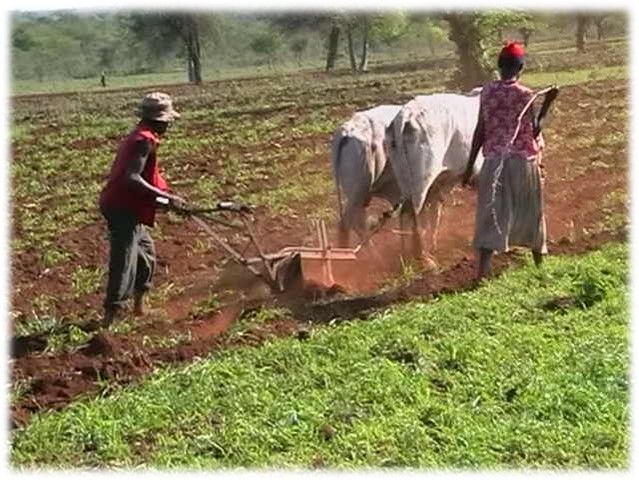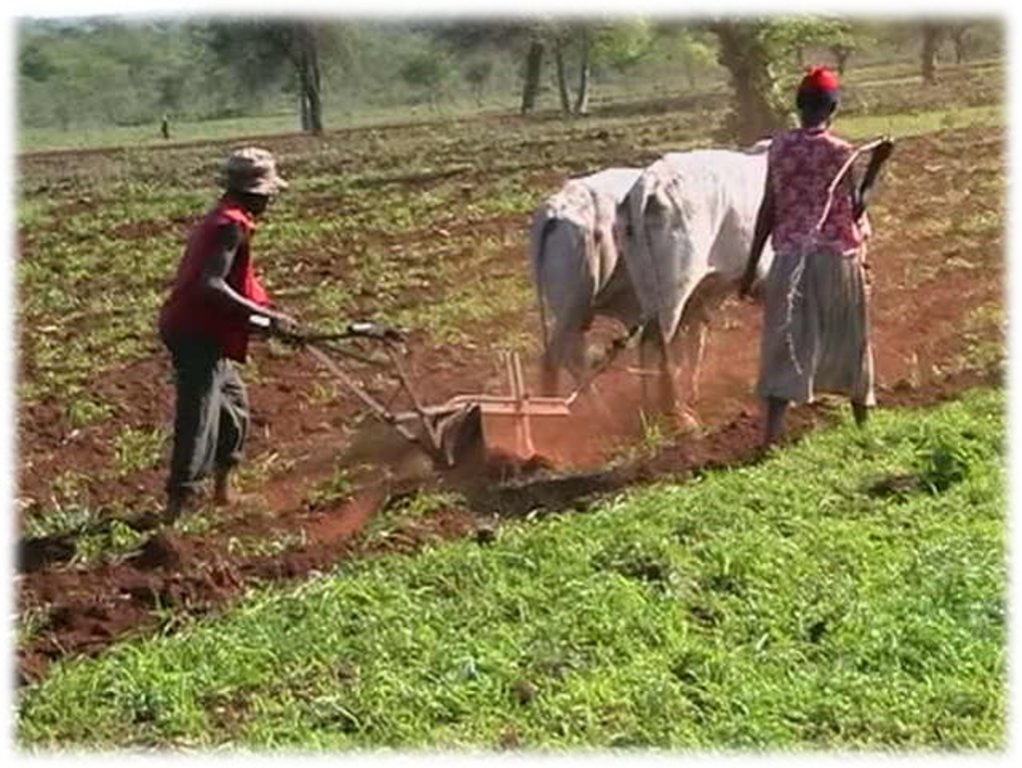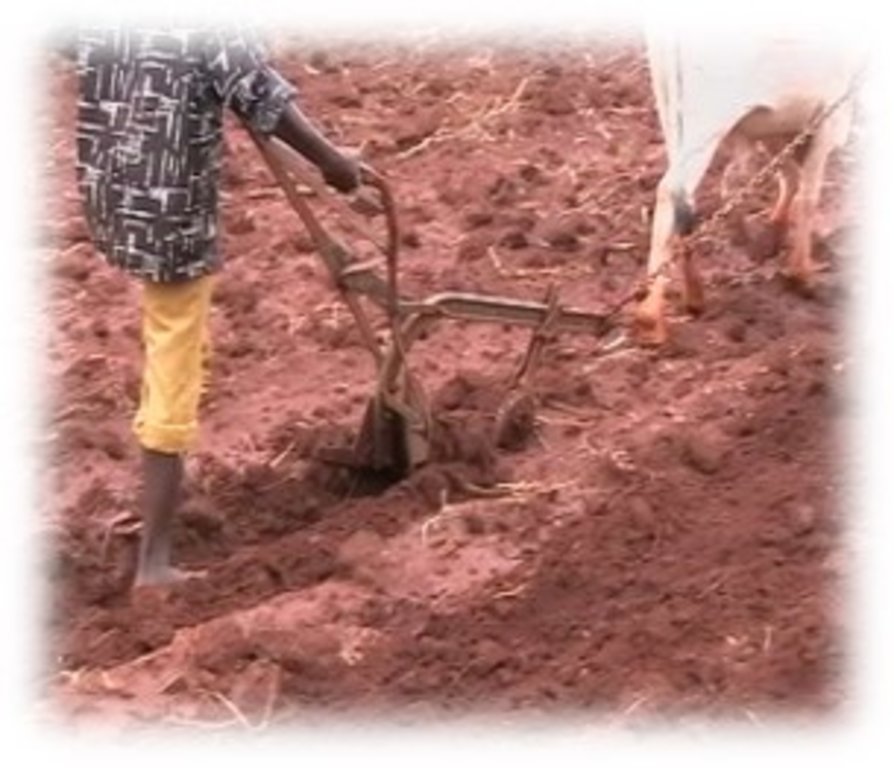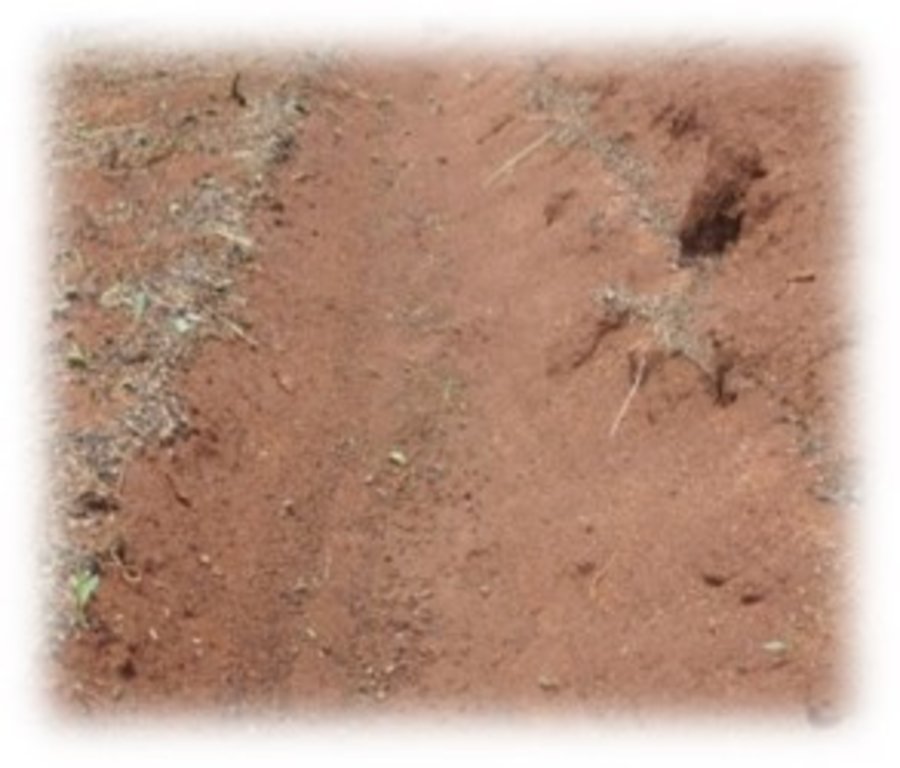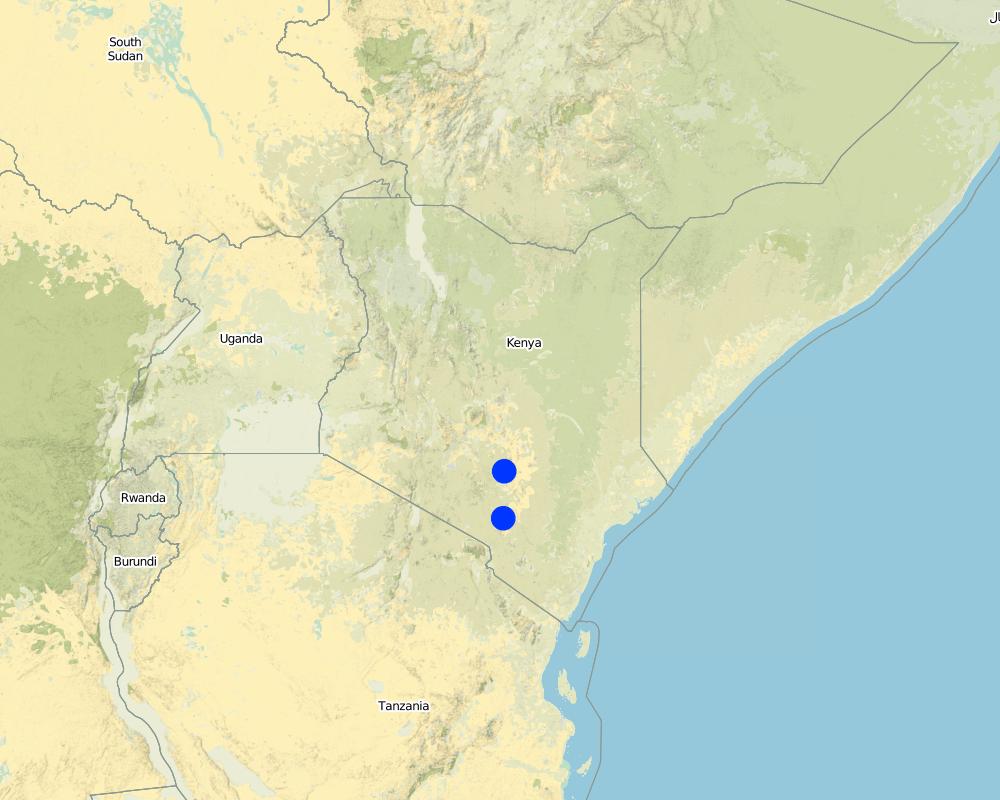Micro-catchments for rainwater harvesting [肯尼亚]
- 创建:
- 更新:
- 编制者: Kevin Mganga
- 编辑者: –
- 审查者: Rima Mekdaschi Studer, Nicole Harari
Micro-catchments
technologies_2895 - 肯尼亚
查看章节
全部展开 全部收起1. 一般信息
1.2 参与该技术评估和文件编制的资源人员和机构的联系方式
1.3 关于使用通过WOCAT记录的数据的条件
(现场)数据是什么时候汇编的?:
01/10/2010
编制者和关键资源人员接受有关使用通过WOCAT记录数据的条件。:
是
1.4 所述技术的可持续性声明
这里所描述的技术在土地退化方面是否存在问题,导致无法被认为是一种可持续的土地管理技术?:
否
注释:
Rainwater harvesting using furrow micro-catchments created by ox-driven plough is a common practice among agropastoral communities in semi-arid southeastern Kenya. It is an important component of seedbed preparation prior to the planting season. This technology is aimed at harvesting rainwater to prolong water availability and soil moisture content for seed germination and subsequent growth and development of the emerging seedlings.
1.5 请参阅有关SLM方法的问卷

water harvesting [肯尼亚]
Water harvesting for agricultural production in ASALS.
- 编制者: Philippe Zahner
2. SLM技术的说明
2.1 技术简介
技术定义:
Ox-ploughed furrow micro-catchments are intentionally built as part of seedbed preparation to harvest rainwater. Commonly used in dryland environments, the micro-catchment prolong water availability for seed germination and growth and development of the emerging seedlings.
2.2 技术的详细说明
说明:
Creation of furrow micro-catchments using an ox-driven plough is a traditional seedbed preparation practice among agropastoral communities inhabiting arid and semi-arid environments in Kenya. The process involves minimal soil disturbance by intentionally creating shallow furrows (about 20 cm depth) using an ox-driven plough. Oxen commonly used predominantly have a light and bright skin coat. This is aimed at reflecting away excess heat from the sun. Consequently, the oxen are less fatigued and can therefore plough for a longer period of time. The furrow microcatchments are intentionally created across the slope to harvest rainwater to prolong water availability for seed germnination and subsequent growth and development of emerging seedlings. Furthermore, the ox-plough breaks the soil hard-pan common in dryland environments. Therefore, the microcatchments also facilitate seedling root penetration to the lower horizons. Prolonged water availability, especially in dryland environments, promotes growth and development of fast growing and early maturing drought tolerant crops and indigenous pasture production, consequently better crop yields and pasture production.
2.3 技术照片
2.5 已应用该技术的、本评估所涵盖的国家/地区/地点
国家:
肯尼亚
区域/州/省:
Kibwezi, Eastern Kenya
有关地点的进一步说明:
Kibwezi, Makueni County, Kenya
注释:
Locations i.e. Kibwezi (Makueni County) and Kitui (Kitui County) are typical semi-arid environments in southeastern Kenya, where creation of micro-catchments using ox-driven plough is a traditional practice.
Map
×2.6 实施日期
如果不知道确切的年份,请说明大概的日期:
- 50多年前(传统)
2.7 技术介绍
详细说明该技术是如何引入的:
- 作为传统系统的一部分(> 50 年)
3. SLM技术的分类
3.1 该技术的主要目的
- 改良生产
- 减少、预防、恢复土地退化
3.2 应用该技术的当前土地利用类型

农田
- 一年一作

牧场
粗放式放牧场:
- 游牧
- 半游牧/游牧
- 经营牧场
3.3 有关土地利用的更多信息
该技术所应用土地的供水:
- 雨养
每年的生长季节数:
- 2
具体说明:
Two rainy seasons in Kenya; long rains (March-April-May), short rains (October-November-December)
3.4 该技术所属的SLM组
- 最小的土壤扰动
- 土壤肥力综合管理
- 集水
3.5 技术传播
具体说明该技术的分布:
- 均匀地分布在一个区域
如果该技术均匀地分布在一个区域上,请注明覆盖的大致区域。:
- > 10,000 平方千米
注释:
Common practice in southeastern Kenya counties of Kitui (24,000 km2), Machakos (5900 km2), and Makueni (8000 km2)
3.6 包含该技术的可持续土地管理措施

农艺措施
- A3:土壤表面处理

结构措施
- S4:平沟、坑
3.7 该技术强调的主要土地退化类型

土壤水蚀
- Wt:表土流失/地表侵蚀

物理性土壤退化
- Pc:压实
- Pi:覆土
3.8 防止、减少或恢复土地退化
具体数量名该技术与土地退化有关的目标:
- 减少土地退化
- 修复/恢复严重退化的土地
4. 技术规范、实施活动、投入和成本
4.1 该技术的技术图纸
4.2 技术规范/技术图纸说明
Ox-ploughed furrow micro-catchments 15-20 cm deep and 10-15 cm wide. This is a typical traditional method of seedbed preparation in the arid and semi-arid lands (ASALs) in southeastern Kenya. The micro-cathcments are intentionally made prior to the rainy season. Thereafter, the seeds are then sown along the micro-catchments to harvest rainwater. This prolongs water availability and maintains sufficient soil moisture content to facilitate germination and subsequent growth and development of the seedlings. Moreover, the ox-driven plough breaks the soil hard-pan common in dryland environments. This minimal soil disturbance promotes root penetration.
Seeds are covered with light amount of soil to facilitate seedling emergence.
Generally, the micro-catchments are created across the slope. Slope should be generally flat or very gentle (<5%) to reduce the speed of run-off, thus prevent soil erosion.
4.3 有关投入和成本计算的一般信息
具体说明成本和投入是如何计算的:
- 每个技术区域
注明尺寸和面积单位:
Hectare
具体说明成本计算所用货币:
- 美元
注明雇用劳工的每日平均工资成本:
5
4.4 技术建立活动
| 活动 | 措施类型 | 时间 | |
|---|---|---|---|
| 1. | Creation of furrow micro-catchments with ox-plough | 植物性的 | Before onset of rains |
4.5 技术建立所需要的费用和投入
| 对投入进行具体说明 | 单位 | 数量 | 单位成本 | 每项投入的总成本 | 土地使用者承担的成本% | |
|---|---|---|---|---|---|---|
| 劳动力 | Casual and Household Labour | person-days | 1.0 | 20.0 | 20.0 | 100.0 |
| 设备 | Hiring ox-driven plough | person-days | 1.0 | 400.0 | 400.0 | 100.0 |
| 技术建立所需总成本 | 420.0 | |||||
4.6 维护/经常性活动
| 活动 | 措施类型 | 时间/频率 | |
|---|---|---|---|
| 1. | Re-ploughing and enforcing micro-catchments | 植物性的 | Before onset of next rains |
4.7 维护/经常性活动所需要的费用和投入(每年)
| 对投入进行具体说明 | 单位 | 数量 | 单位成本 | 每项投入的总成本 | 土地使用者承担的成本% | |
|---|---|---|---|---|---|---|
| 劳动力 | Casual and household labour | person-days | 1.0 | 5.0 | 5.0 | 100.0 |
| 设备 | Hiring ox-driven plough | person-days | 1.0 | 400.0 | 400.0 | 100.0 |
| 技术维护所需总成本 | 405.0 | |||||
4.8 影响成本的最重要因素
描述影响成本的最决定性因素:
Cost of hiring ox-plough - before the onset of the rains, there is a high demand for ox-ploughs for seedbed preparation and creation of micro-catchments. This increased demand (i.e. hiring the ox-plough) greatly influences the costs.
5. 自然和人文环境
5.1 气候
年降雨量
- < 250毫米
- 251-500毫米
- 501-750毫米
- 751-1,000毫米
- 1,001-1,500毫米
- 1,501-2,000毫米
- 2,001-3,000毫米
- 3,001-4,000毫米
- > 4,000毫米
有关降雨的规范/注释:
Highly variable in amount, space, time and period.
注明所考虑的参考气象站名称:
DWA Sisal Plantation Kibwezi and Makindu Meteorological Department
农业气候带
- 半干旱
5.2 地形
平均坡度:
- 水平(0-2%)
- 缓降(3-5%)
- 平缓(6-10%)
- 滚坡(11-15%)
- 崎岖(16-30%)
- 陡峭(31-60%)
- 非常陡峭(>60%)
地形:
- 高原/平原
- 山脊
- 山坡
- 山地斜坡
- 麓坡
- 谷底
垂直分布带:
- 0-100 m a.s.l.
- 101-500 m a.s.l.
- 501-1,000 m a.s.l.
- 1,001-1,500 m a.s.l.
- 1,501-2,000 m a.s.l.
- 2,001-2,500 m a.s.l.
- 2,501-3,000 m a.s.l.
- 3,001-4,000 m a.s.l.
- > 4,000 m a.s.l.
说明该技术是否专门应用于:
- 凸形情况
5.3 土壤
平均土层深度:
- 非常浅(0-20厘米)
- 浅(21-50厘米)
- 中等深度(51-80厘米)
- 深(81-120厘米)
- 非常深(> 120厘米)
土壤质地(表土):
- 粗粒/轻(砂质)
- 中粒(壤土、粉土)
土壤质地(地表以下> 20厘米):
- 粗粒/轻(砂质)
- 中粒(壤土、粉土)
表土有机质:
- 中(1-3%)
- 低(<1%)
如有可能,附上完整的土壤描述或具体说明可用的信息,例如土壤类型、土壤酸碱度、阳离子交换能力、氮、盐度等。:
Luvisol, %C 0.75-1.56%; %N 0.3-0.4%; P 13-15 ppm; CEC 6-19 me/100 g soil; K 1-2 me/100 g soil; Bulk density 1.2-1.3 g cm3; soil pH 8
5.4 水资源可用性和质量
地下水位表:
5-50米
地表水的可用性:
中等
水质(未处理):
不良饮用水(需要处理)
水的盐度有问题吗?:
否
该区域正在发生洪水吗?:
否
关于水质和水量的注释和进一步规范:
Water quantity and quality is highly dependant on rainfall
5.5 生物多样性
物种多样性:
- 中等
栖息地多样性:
- 中等
5.6 应用该技术的土地使用者的特征
定栖或游牧:
- 定栖的
- 半游牧的
生产系统的市场定位:
- 生计(自给)
- 混合(生计/商业
非农收入:
- 收入的10-50%
相对财富水平:
- 贫瘠
- 平均水平
个人或集体:
- 个人/家庭
- 团体/社区
机械化水平:
- 手工作业
- 畜力牵引
性别:
- 女人
- 男人
土地使用者的年龄:
- 青年人
- 中年人
5.7 应用该技术的土地使用者拥有或租用的平均土地面积
- < 0.5 公顷
- 0.5-1 公顷
- 1-2 公顷
- 2-5公顷
- 5-15公顷
- 15-50公顷
- 50-100公顷
- 100-500公顷
- 500-1,000公顷
- 1,000-10,000公顷
- > 10,000公顷
这被认为是小规模、中规模还是大规模的(参照当地实际情况)?:
- 小规模的
- 中等规模的
5.8 土地所有权、土地使用权和水使用权
土地所有权:
- 社区/村庄
- 个人,有命名
土地使用权:
- 社区(有组织)
- 个人
用水权:
- 社区(有组织)
- 个人
注释:
Land use rights - both communal and individual
Water use rights - both communal and individual
5.9 进入服务和基础设施的通道
健康:
- 贫瘠
- 适度的
- 好
教育:
- 贫瘠
- 适度的
- 好
技术援助:
- 贫瘠
- 适度的
- 好
就业(例如非农):
- 贫瘠
- 适度的
- 好
市场:
- 贫瘠
- 适度的
- 好
能源:
- 贫瘠
- 适度的
- 好
道路和交通:
- 贫瘠
- 适度的
- 好
饮用水和卫生设施:
- 贫瘠
- 适度的
- 好
金融服务:
- 贫瘠
- 适度的
- 好
6. 影响和结论性说明
6.1 该技术的现场影响
社会经济效应
生产
作物生产
饲料生产
生态影响
土壤
土壤水分
注释/具体说明:
Rainwater harvested along micro-catchments improves soil moisture content and prolongs water availability.
土壤流失
注释/具体说明:
Micro-catchments reduce the kinetic energy of rainwater by trapping runoff, thus reduce soil loss.
6.2 该技术的场外影响已经显现
对邻近农田的破坏
注释/具体说明:
Damage on neighbours fields is greatly reduced. Micro-catchments trap rainwater, thus reduces runoff which might damage a neighbours field, especially located downslope.
对公共/私人基础设施的破坏
注释/具体说明:
Damage on public and private roads is greatly reduced. Micro-catchments trap rainwater, thus reduces runoff which might damage infrastructure
6.3 技术对渐变气候以及与气候相关的极端情况/灾害的暴露和敏感性(土地使用者认为的极端情况/灾害)
渐变气候
渐变气候
| 季节 | 气候变化/极端天气的类型 | 该技术是如何应对的? | |
|---|---|---|---|
| 年降雨量 | 减少 | 适度 | |
| 季雨量 | 湿季/雨季 | 减少 | 适度 |
6.4 成本效益分析
技术收益与技术建立成本相比如何(从土地使用者的角度看)?
短期回报:
稍微积极
长期回报:
稍微积极
技术收益与技术维护成本/经常性成本相比如何(从土地使用者的角度看)?
短期回报:
稍微积极
长期回报:
稍微积极
6.5 技术采用
- 大于 50%
在所有采用这项技术的人当中,有多少人是自发地采用该技术,即未获得任何物质奖励/付款?:
- 50-90%
6.6 适应
最近是否对该技术进行了修改以适应不断变化的条件?:
否
6.7 该技术的优点/长处/机会
| 土地使用者眼中的长处/优势/机会 |
|---|
| Relatively a cheap method of in-situ rainwater harvesting to harness water availability for crop and pasture production. |
| Prolong rainfed water availability |
| Breaks the soil hardpan developed over time due to continuous cultivation and hoof action of grazing animals. This promotes rainwater infiltration to lower horizon, thus minimizes runoff. |
| Reduced human labour requirement and faster method of seedbed preparation compared to hand held hoe |
| 编制者或其他关键资源人员认为的长处/优势/机会 |
|---|
| Breaks the soil hardpan developed over time due to continuous cultivation and hoof action of grazing animals. This promotes rainwater infiltration to lower horizon, thus minimizes runoff. |
| Prolong rainfed water availability |
| Relatively cheap |
| Reduced human labour requirement and faster method of seedbed preparation compared to hand held hoe |
6.8 技术的弱点/缺点/风险及其克服方法
| 土地使用者认为的弱点/缺点/风险 | 如何克服它们? |
|---|---|
| Ox-plough availability and accessibility i.e. demand, if not individually owned | Supply affordable ox-driven ploughs to rural households |
| Oxen need training before they can be used for ploughing. This takes some time. | Research outreach and extension services |
| Oxen get exhausted thus can´t plough for many hours in the drylands | Simple and light mechanization for creating furrow microcatchments |
| 编制者或其他关键资源人员认为的弱点/缺点/风险 | 如何克服它们? |
|---|---|
| High costs of hiring ox-ploughs when in high demand | Joint ownership of ox-ploughs among neighbours, agropastoral farmer groups to eliminate the cost of hiring. |
| Semi-permanent - i.e. don´t last beyond a growing season and therefore new ones need to be created every growing season. | Creation of macrocatchments and/or trenches that are deeper and last longer. |
7. 参考和链接
7.1 信息的方法/来源
- 实地考察、实地调查
>40 informants
- 与土地使用者的访谈
> 40 land users
7.2 参考可用出版物
标题、作者、年份、ISBN:
KZ Mganga, NKR Musimba, MM Nyangito, DM Nyariki, AW Mwang’ombe. 2015. The choice of grass species to combat desertification in semi-arid Kenyan rangelands is greatly influenced by their forage value for livestock. Grass and Forage Science 70: 161-167.
可以从哪里获得?成本如何?
Grass and Forage Science Journal; USD 38
标题、作者、年份、ISBN:
3. KZ Mganga, NKR Musimba, DM Nyariki. 2015. Combining sustainable land management technologies to combat land degradation and improve rural livelihoods in semi-arid lands in Kenya. Environmental Management 56: 1538-1548
可以从哪里获得?成本如何?
Environmental Management Journal, USD 43.34
标题、作者、年份、ISBN:
2. KZ Mganga, NKR Musimba, DM Nyariki. 2015. Competition indices of three perennial grasses used to rehabilitate degraded semi-arid rangelands in Kenya. The Rangelands Journal 37: 489-495
可以从哪里获得?成本如何?
The Rangelands Journal, USD 25
7.3 链接到网络上可用的相关信息
标题/说明:
The choice of grass species to combat desertification in semi-arid Kenyan rangelands is greatly influenced by their forage value for livestock
URL:
http://onlinelibrary.wiley.com/doi/10.1111/gfs.12089/abstract
标题/说明:
Combining Sustainable Land Management Technologies to Combat Land Degradation and Improve Rural Livelihoods in Semi-arid Lands in Kenya
URL:
https://link.springer.com/article/10.1007%2Fs00267-015-0579-9
标题/说明:
Competition indices of three perennial grasses used to rehabilitate degraded semi-arid rangelands in Kenya
URL:
http://www.publish.csiro.au/RJ/RJ15023
链接和模块
全部展开 全部收起链接

water harvesting [肯尼亚]
Water harvesting for agricultural production in ASALS.
- 编制者: Philippe Zahner
模块
无模块


